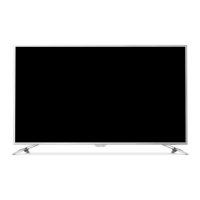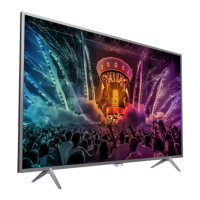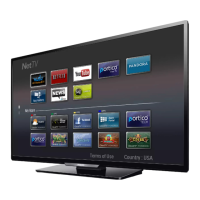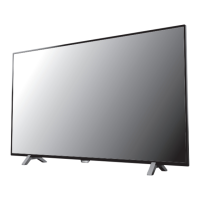Do you have a question about the Philips 49PUS7502/12 and is the answer not in the manual?
Details releasing clips, unplugging connectors, and removing screws for the SSB.
Instructions for gently unplugging connectors from the PSU.
Detailed steps for removing the LCD Panel, including other components first.
Details the types of service modes (SAM, Factory, CSM) and their functionalities for engineers.
Explains the purpose, specifications, and activation methods for SAM.
Outlines the purpose and specifications of Factory mode for alignments.
Details the key sequence to enter Factory mode.
Explains how to exit the Factory mode.
Describes CSM's purpose and specifications for customer-level fault reporting.
Provides the key sequence to activate CSM for customer diagnostics.
Details the steps for preparing and performing a firmware upgrade via USB.
Instructions to check the software version after the upgrade using Factory mode.
Explains the purpose and structure of error codes and the error buffer.
Introduces error codes and their role in indicating TV failures and protection states.
Describes methods to read the error buffer via SAM/CSM or blinking LED.
Lists layer 2 error codes that point to SSB problems, triggered by LED blinking.
Explains how to clear the error buffer using SAM, Factory mode, or a remote key sequence.
Details the procedure for setting the panel code using a specific RC transmitter sequence.
Introduces the TPM17.1E LA chassis, its launch date, platform, and supported stylings.
Lists the main components of the chassis, such as Scalers, Demodulators, and Tuners.
Shows a block diagram illustrating the main ICs and their interconnections.
Describes the power architecture and unit, including deltas and control signals.
Explains PSU serviceability, ordering codes, and platform deltas for LED backlight.
Describes the front-end components for analogue and digital TV reception.
Details the features of the MT5596UGIJ processor for video and audio.
Provides the IC data sheet for the MT5596UGIJ, the main processor.
Provides the IC data sheet for the NT72333TBG/BA chip.
Provides the AC input schematic for the 715G8620 PSU used in 43" 6412 series.
Shows the schematic for the PFC stage of the power supply.
Provides the main power schematic, including standby and +12V circuits.
Provides the AC input schematic for the 715G8672 PSU used in 49"/55" 6412/6482/7502 series.
Provides the AC input schematic for the 715G8682 PSU used in 55"/65" 6482/7002 series.
Provides the AC input schematic for the 715G8886 PSU used in 55" 9002 series.
Provides the schematic for the SOC-EMMC section of the SSB.
Provides the schematic for the first-class D audio amplifier, including speaker connectors.
Provides the schematic for the second-class D audio amplifier and audio module SPDIF output.
Details the connections for HDMI ports 1, 2, 3, and 4, including TMDS RX signals.
Provides the schematic for the SOC-EMMC section of the SSB.
Details the audio amplifier circuit, including mute circuit and SPDIF output.
Provides the schematic for the first-class D audio amplifier, including speaker connectors.
Details the second-class D amplifier circuit, including mute circuit and audio module outputs.
Provides the schematic for the second-class D audio amplifier and audio module SPDIF output.
Provides the schematic for the second-class D audio amplifier, including speaker connectors.
Details the connections for HDMI ports 1, 2, 3, and 4, including TMDS RX signals.
Details the connections for HDMI ports 1, 2, 3, and 4, including TMDS RX signals.
Details releasing clips, unplugging connectors, and removing screws for the SSB.
Instructions for gently unplugging connectors from the PSU.
Detailed steps for removing the LCD Panel, including other components first.
Details the types of service modes (SAM, Factory, CSM) and their functionalities for engineers.
Explains the purpose, specifications, and activation methods for SAM.
Outlines the purpose and specifications of Factory mode for alignments.
Details the key sequence to enter Factory mode.
Explains how to exit the Factory mode.
Describes CSM's purpose and specifications for customer-level fault reporting.
Provides the key sequence to activate CSM for customer diagnostics.
Details the steps for preparing and performing a firmware upgrade via USB.
Instructions to check the software version after the upgrade using Factory mode.
Explains the purpose and structure of error codes and the error buffer.
Introduces error codes and their role in indicating TV failures and protection states.
Describes methods to read the error buffer via SAM/CSM or blinking LED.
Lists layer 2 error codes that point to SSB problems, triggered by LED blinking.
Explains how to clear the error buffer using SAM, Factory mode, or a remote key sequence.
Details the procedure for setting the panel code using a specific RC transmitter sequence.
Introduces the TPM17.1E LA chassis, its launch date, platform, and supported stylings.
Lists the main components of the chassis, such as Scalers, Demodulators, and Tuners.
Shows a block diagram illustrating the main ICs and their interconnections.
Describes the power architecture and unit, including deltas and control signals.
Explains PSU serviceability, ordering codes, and platform deltas for LED backlight.
Describes the front-end components for analogue and digital TV reception.
Details the features of the MT5596UGIJ processor for video and audio.
Provides the IC data sheet for the MT5596UGIJ, the main processor.
Provides the IC data sheet for the NT72333TBG/BA chip.
Provides the AC input schematic for the 715G8620 PSU used in 43" 6412 series.
Shows the schematic for the PFC stage of the power supply.
Provides the main power schematic, including standby and +12V circuits.
Provides the AC input schematic for the 715G8672 PSU used in 49"/55" 6412/6482/7502 series.
Provides the AC input schematic for the 715G8682 PSU used in 55"/65" 6482/7002 series.
Provides the AC input schematic for the 715G8886 PSU used in 55" 9002 series.
Provides the schematic for the SOC-EMMC section of the SSB.
Provides the schematic for the first-class D audio amplifier, including speaker connectors.
Provides the schematic for the second-class D audio amplifier and audio module SPDIF output.
Details the connections for HDMI ports 1, 2, 3, and 4, including TMDS RX signals.
Provides the schematic for the SOC-EMMC section of the SSB.
Details the audio amplifier circuit, including mute circuit and SPDIF output.
Provides the schematic for the first-class D audio amplifier, including speaker connectors.
Details the second-class D amplifier circuit, including mute circuit and audio module outputs.
Provides the schematic for the second-class D audio amplifier and audio module SPDIF output.
Provides the schematic for the second-class D audio amplifier, including speaker connectors.
Details the connections for HDMI ports 1, 2, 3, and 4, including TMDS RX signals.
Details the connections for HDMI ports 1, 2, 3, and 4, including TMDS RX signals.












